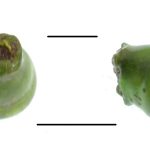
Medieval jewellery in the hands of Polish scientists
According to archaeological research, in medieval Poland, lead glass jewellery was mass-produced from lead glass, and the raw material for beads and rings production came from Polish deposits.
The study’s findings were published in the prestigious Journal of Archaeological Science by a team of scientists from the University of Wrocław, Institute of Archaeology and Ethnology of the Polish Academy of Sciences, Jagiellonian University, National Centre for Nuclear Research, University of Warsaw, Jan Długosz University in Częstochowa, and Juniata College in the USA. The lead author of the study was dr hab. Aleksandra Pankiewicz from the Institute of Archaeology at the University of Wrocław.
The isotopic analysis of lead glass ornaments originating from Wrocław was conducted at the Institute of Archaeology of the University of Wrocław, with the support of a grant from the National Science Centre. Additionally, financial support from the Excellence Initiative – Research University project at the University of Wrocław enabled the article to be published in open access.
Scope of the study
In most regions during the Middle Ages, lead glass was used for producing small objects, ornaments, or glaze. However, in some cultures, it was also used for making tableware. In the early Middle Ages, it primarily consisted of a mixture of silica and lead oxide. Later, the amount of lead oxide used in its production gradually decreased.
The oldest beads made of lead glass date back to the Eighteenth Dynasty of Egypt (c. 1450–1425 BC). The earliest documented recipes for lead-containing glass appear in Mesopotamian texts from the 7th century BC.
In Europe, the recipe for making lead glass became widespread between the 10th and 14th centuries.
The technique for producing lead glass most likely reached Europe from Southeast Asia via the Silk Road. This type of lead glass was produced on the Iberian Peninsula, in present-day Germany, Poland, and probably in Rus’ and the Caucasus.
On the border between Lesser Poland and Silesia, there are lead deposits that have been exploited since at least the Iron Age. Research has shown that these deposits were already in use in the 6th century BC, reaching their peak of exploitation in the 11th century.
Researchers from the University of Wrocław, the Jagiellonian University, the National Centre for Nuclear Research, the University of Warsaw, Jan Długosz University in Częstochowa, and the Institute of Archaeology and Ethnology of the Polish Academy of Sciences, in collaboration with Juniata College in the USA, carried out analyses of lead isotope ratios in glass jewellery found at a hillfort in Wrocław and at a grave field in Sypniewo (Masovian Voivodeship).
The results were published in a prestigious journal Journal of Archaeological Science
Who wore this kind of jewellery? Generally, beads and rings are considered typically feminine, but this is not entirely true. Some rings (only yellow and black) are so large that they certainly were not intended for a woman’s hand. However, beads are sometimes found in male graves. It is not known whether they were, for example, a memento of a late wife or if the man himself wore such ornaments. – I believe it could be both – says dr. hab. Aleksandra Pankiewicz.
More information about the research can be found on the Nauka w Polsce portal Biżuterię ze szkła ołowiowego masowo wytwarzano w średniowiecznej Polsce | Nauka w Polsce
























Complied by kg
Date of publication: 18.03.2025
Added by: M.J.



